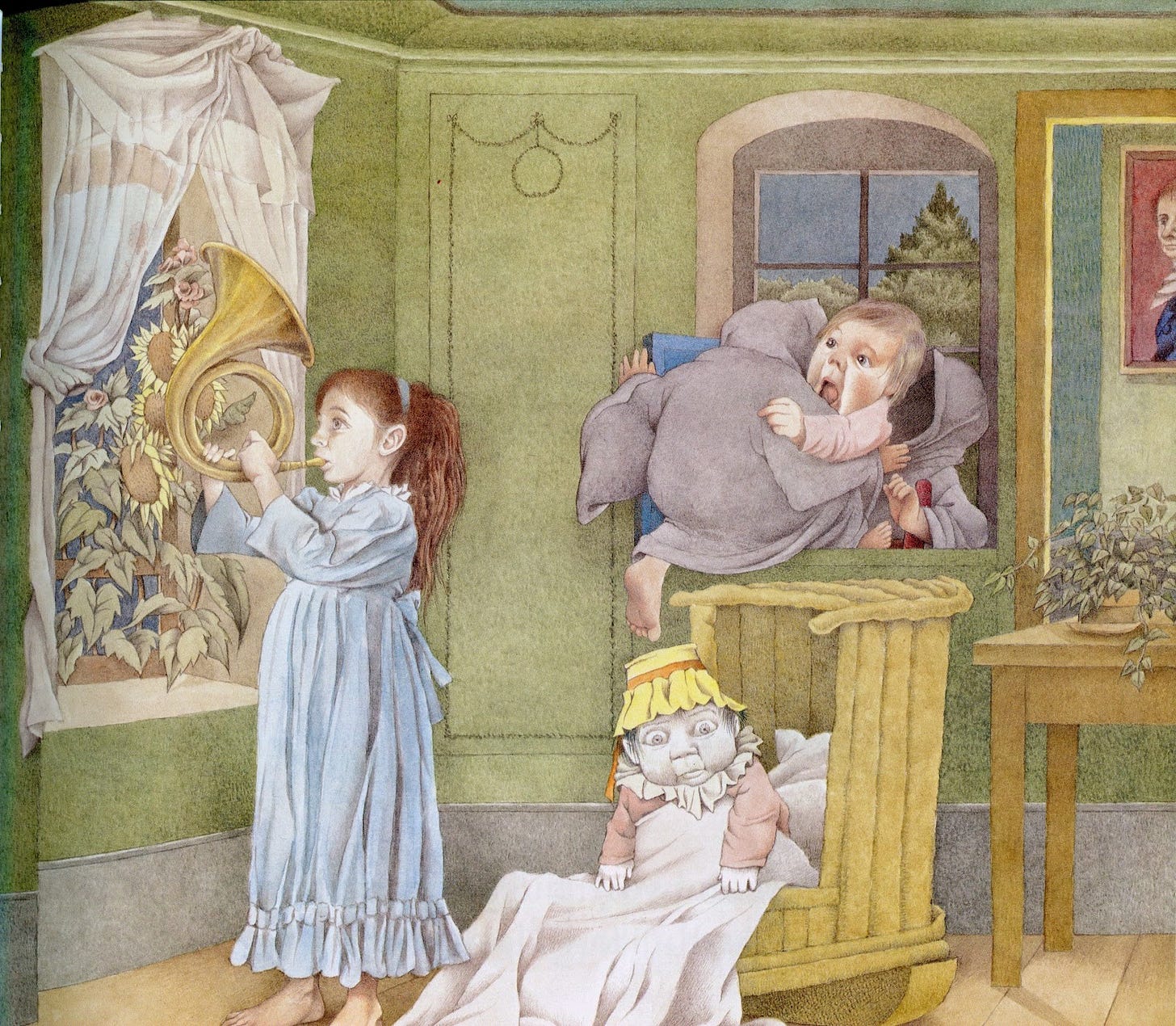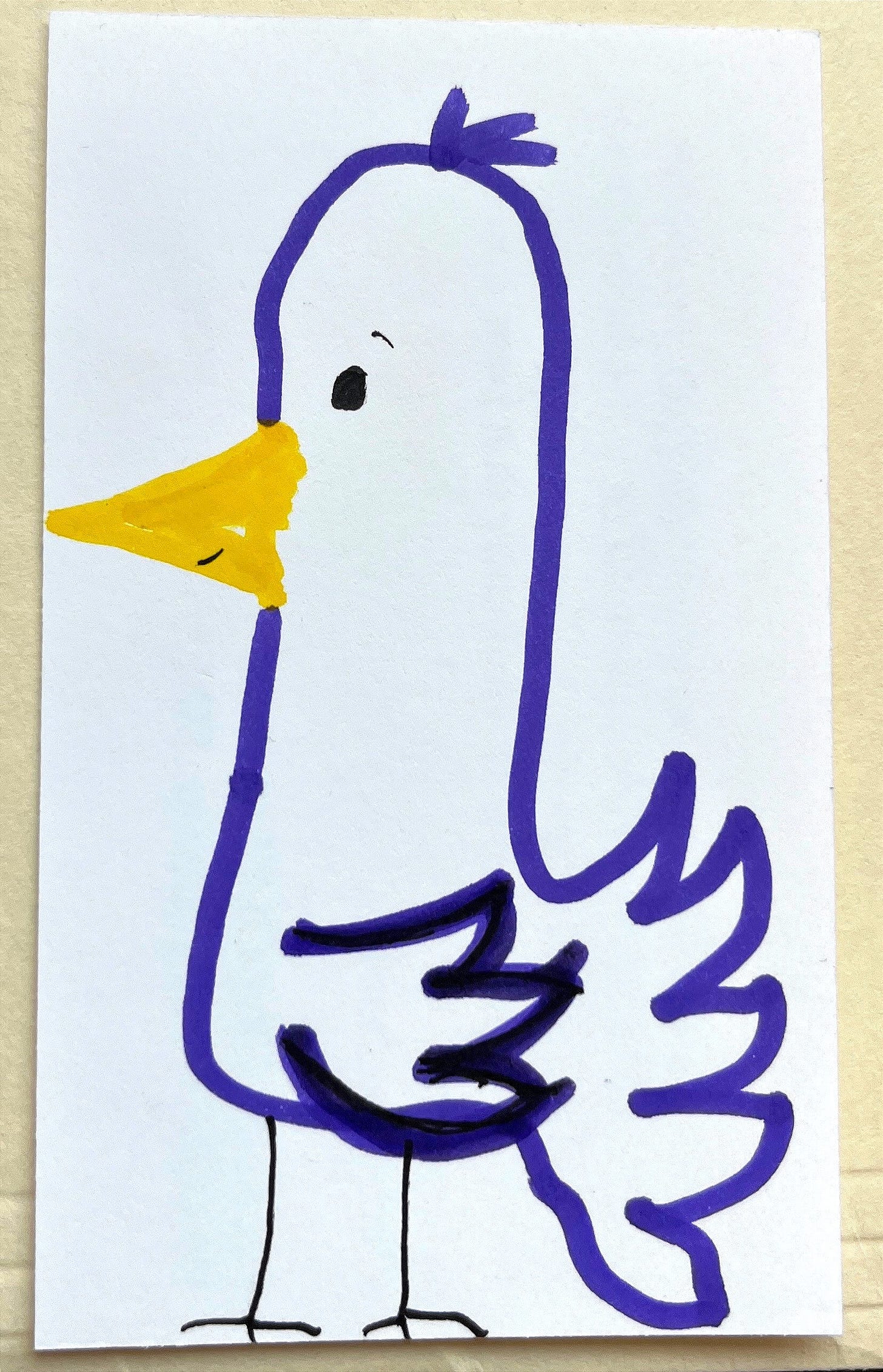Mr. Watson's Purple Feathered Friends, Part 1
On Creativity, Dreams, and the Writing of a Picture Book
In the way a dream comes to us at night, feelings come to me, and then I must rush to put them down. But these fantasies have to be given physical form, so you build a house around them, and the house is what you call a story, and the painting of the house is the bookmaking. But essentially it’s a dream, or it’s a fantasy.
—Maurice Sendak, Questions to an Artist Who is Also an Author1
Since before my kids were born, I’ve wanted to write for children and teens, to “build houses,” as Sendak put it, in the form of stories for kids. The act of reading gets me as close to a kind of meditative state of wakeful dreaming that’s more immersive and oxygenating than anything else I’ve tried. As a kid, this kind of dreaming was critical to feeling safe and becoming a sentient person. Reading provided an escape from familial chaos and also made me feel powerful, in control: the longer I did it, the more I could regulate and release my emotions (laughter always provided immense relief), understand my perceptions and feelings (which I was often told were not real), and expand my awareness and appreciation of the world, its people, its creatures, and maybe even matters beyond material life on Earth. Newly fortified, I could return to the world, a little surer I’d survive.
The content of the books I loved during my formative years, the “memories” I have of scenes, settings, and the sounds of characters’ voices, all conjured in my head out of nothing while reading, have never left me. They’ve shaped who I am. I can’t imagine who I’d have become without them. What if I could take all the sounds, rhythms, memories, thoughts, and feelings that bash and clang around in my head and my heart all day and mold them into books for young readers like the ones I loved?
Despite half-hearted attempts over the years and a seemingly endless amount of promising, but disjointed ideas, images, and dialogue scrawled feverishly in my notebooks, I couldn’t pull a full manuscript together.
It took an actual dream one night to make it happen.
In 2016, I dreamt that I read aloud a book called Mr. Watson’s Chickens – which I had apparently written – to a class of 1st graders at my son’s school. The story was about a man named Mr. Watson and a nameless man with him who had apparently lost all their chickens in a busy city (like you do). They sprinted about searching for their runaway fowl, but to no avail. One by one, the chickens were discovered by different folks each bent out of shape to find weird birds in their midst. “WHOSE CHICKENS ARE THESE?” they bellowed. And each time they did I read this response, “’That’ll be me!’ said Mr. Watson with a 1-2-3!”
The dream was happy. I felt a kind of thermal warmth in my chest like what I imagine chickens must feel underneath their feathers. The dream kids in the classroom laughed, they listened. But it was all cut short. I startled awake like someone had hip checked me or bopped me on the nose with a hockey puck. It was near 4 a.m., but instead of plunging back to sleep, I was alert. “Mr. Watson’s Chickens,” I thought in the dark. “What book was that? I really liked it…” Then I made a choice crucial to writers when a halfway decent idea flits across the mind like a barn swallow hell-bent on catching a fly: I wrote it down.
I rolled out of bed, stood at my dresser in the dark (where I had tossed a pencil and some papers that day), and I wrote what I could remember – the scraps of dialogue, the title of the book, the indignant characters tripping over chickens. My wife woke up and asked, “Are you OK?” I whispered, “Yeah… I just had a dream about chickens.” This seemed to satisfy her, or maybe was just par for the course living with me, and she went back to sleep. In the morning, I discovered the paper on my dresser covered with my (ahem) chicken scrawl and I realized I had a title, a character with a good name, and a scene – the beginnings of a book. I started exploring the story in my notebook later that day.
I worked on the story for months. I regaled my son with versions of the tale as I walked him to school. I sketched pictures of chicken condominium buildings in the margins of my notebooks, I made up nonsense songs, and, most importantly, I made myself laugh. Four years after I dreamt it, that story became my first published picture book—Mr. Watson’s Chickens—illustrated by Andrea Tsurumi, edited by Taylor Norman, and published by Chronicle Books.
This was the first time I’d ever been startled awake by a happy dream, but it wasn’t the first time my dream life had assisted my creative work. I’ve always paid attention to my dreams, thought about them (and felt sometimes haunted by them) during the day, and as an adult I feel they sometimes connect me to a vulnerable, wounded part of myself, a part that’s still the boy I once was.
A recurring nightmare I had when I was 8 years old involved a purple-faced man who resembled a dapper Jeremy Irons in a tuxedo. His face was dark eggplant purple and the skin glistened, like the purple was a kind of always-wet makeup he’d caked on before appearing (similar to how the performers in Blue Man Group look, only purple and with short dark hair). This figure would open my closet door, emerge from within, walk quickly towards me, face impassive, and abduct me. He’d drag me from my bed into the closet and down to a kind of abandoned basement where harsh, fluorescent lights flickered in corners and unreasonable creatures lived (I’d recently seen Labyrinth, Poltergeist, and Nightmare on Elm Street, all of which terrified me, so these dreams didn’t come from nowhere).

Part of what made these nightmares so blood-chilling, and just…so…unfair2 was that my room in the dream looked exactly as the room did before I’d turned out my light. Same lighting, same Cubs baseball cards on my desk, same Def Leppard posters on the wall. My perspective in the dream was from my bed exactly where I’d laid my head. There was no way until after I’d woken up to know that I was dreaming (which also made waking up terrifying to the point of paralysis in the dark—was I awake? Or was I still dreaming?).
These dreams made me petrified of closets, especially closets with dark clothes hanging in them. Whenever my sister and I traded rooms for the night (because we for some reason thought that it would be totally crazy! to switch beds), my pre-sleep ritual involved opening her closet doors wide and removing every article of black, blue, or (gulp) dark purple clothing to another room. If I didn’t do this, every one of her dark dresses and shirts and jackets could actually be the man turned sideways in the dark, waiting for me to slip away, defenseless, into sleep. As for actually falling asleep, I resisted like a boy who could hear wolves in the distance—wasn’t gonna happen (thank you, books, for keeping me awake).

How could I stop suffering from these dreams? How could I cast out my purple-painted abductor?
I didn’t realize it at the time, but I soon hit on an answer.
I soon discovered a way to transpose one burning detail from my dreams into something that made me smile, which was enough to defang my nightmare, which turned my terror on its head.
I started a club called the “Purple Feathered Friends.”
I was around 9 years old, and, as I explained to potential members I recruited from my 4th grade class, the Purple Feathered Friends would gather weekly to “draw purple bird friends doing purple bird things” in a series of purple bird comics and stories that we would turn into “purple bird books.” Somehow no one joined.
Fine, then. It would be a club of one.
One night, after weeks of drawing and writing different adventure stories about the Purple Feathered Friends, I was struck by a realization: I could totally take down the purple-faced man. I could kick his ass. He didn’t have the power, I did. It was my brain after all.
Armed with a plan, one which I’d hatched in my mind before climbing into bed that night, I waited for sleep to take me, for the confrontation.
But, he didn’t show up that night. Or the next. Or the next. But, ever committed to the haunt, as our own private ghouls tend to be, Sir PFM eventually appeared again. But this time cross-eyed little 9-year-old Dream Jarrett was ready.
As he charged towards me, I slipped from my bed into the hall outside my room. There was a closet just to the right of my room’s entrance in the hall and its heavy wooden door covered most of my room’s entrance when opened to a full yawn. Just as Mr. Dapper Kidnapper walked across the threshold, I threw the closet door open and smashed it right in his face! He staggered back like Buster Keaton into my room, holding his ringing face. As he did, he tripped over a record player on the floor and stumbled. He then fell ass-over-teakettle backwards into the closet where he disappeared.
He never visited me again.
AW YEAH! Take that, Violet Irons! Who’s the punk-ass loser now, Cocktail Party Eggplant Man!?
I don’t know for sure if the work I did on my bird comics was the key that unlocked the courage I needed to face down my monster, but it makes sense to me if it did. I referred to the guy only as ‘the Purple Faced Man’ when I described these nightmares to friends at school. Purple was a detail that defined the dreams when I remembered them. And the birds I populated my comic aviary with were purple-feathered. Maybe I’d unconsciously used the color purple in my comics in order to transform the color purple from terrifying-face-of-the-man-I-fear to simply the-color-of-some-curious-and-sweet-birds-that-like-to-ride-bikes-together-and-collect-custom-post-it-notes.
When I worked on my comics, purple became not a reminder of the creeping shadow lying in wait for me in my room, but simply the color of some feathered pals I’d created who had my back. Maybe this act of creation had neutralized the color purple in my subconscious, allowing me to see the Nightmare Man for who he really was: an image from a story conjured in my head, one that I had the power to re-write and change.
To be continued.
Parts of this essay were originally published in the Winter 2022 issue of Prairie Wind, a bulletin of the Illinois Chapter of the Society of Children’s Book Writers & Illustrators and are reprinted here with their permission. If you aspire to write books for children and teens, I highly recommend joining SCBWI and taking advantage of all the resources they have to offer.
___________________________________
Thank you for reading! I intend to make this newsletter free for all to read, but if you’d like to keep my writing here going, please consider becoming a paid subscriber or founding member. Your support will ensure every article remains open to everyone. Those who elect to become founding members will receive an original zine written, designed, and created by me in the mail. Monthly subscribers will receive I’m with the Banned stickers and bookmarks! I appreciate your support.
“Questions to an Artist Who Is Also an Author: A Conversation between Maurice Sendak and Virginia Haviland.” The Quarterly Journal of the Library of Congress 28, no. 4 (October 1, 1971): 262–80. https://search.ebscohost.com/login.aspx?direct=true&db=edsjsr&AN=edsjsr.29781488&site=eds-live&scope=site.
Like, come on, what the actual fwip are you doing up there, brain? Pull it together! If this is the result of some kind of stand-off between you and my subconscious, could you possibly work it out?!





What cool inspiration for your book -- a wonderful book that everyone should read!! Thank you for sharing your thoughts.